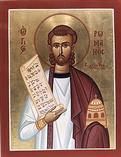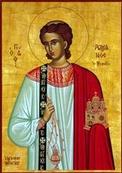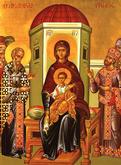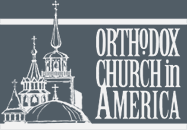
|
Icon of the Annuciation to the Theotokos (Image)This icon depicts the Archangel Gabriel and the Theotokos as the Angel of God appeared to the Virgin Mary to announce the birth of Christ. (Luke 1:26-37). St. Nicholas Cabasilas says, "The Incarnation was not only the work of the Father, of His Power and His Spirit: it was also the work of the will and the faith of the Virgin." In the words of another holy hierarch, "All creation held its breath, wondering what her answer would be." The Virgin was taken by surprise and was quite afraid, but answered simply, "Behold the handmaiden of the Lord; be it unto me according to thy word." When God elected to become man, He desired to do so with the willing agreement of her whom He chose as His mother. The Virgin was a willing participant in God's grace for mankind. She played an active and positive role in God's plan of salvation. The red thread that she is holding represents that it was she who wove the veil in the Temple that later was miraculously rent from top to bottom at the death of her Son. Her acceptance of God's will is depicted in this icon by her upraised and open hand. |
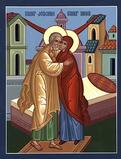
|
Icon of the Conception of the Theotokos (Image)Ss. Joachim & Anna were childless for 50 years of their married life. Then the Archangel Gabriel appeared to them, each separately, and foretold the birth of a daughter. God had heard their prayers. They had always been very devout and gave one third of their income to the Temple, one third to the poor and lived on the remaining third. St. Joachim lived to be 80 and St. Anna lived to be 79. In response to the blessing and the Archangel's prophecy, they dedicated Mary to the Lord and presented her to be raised in the Temple from a young child. |

|
Icon of The Crucifixion of the Lord (Image)Crucifixion was a cruel method of execution but one that the Lord willingly endured for mankind. Christ is shown dead in this icon to emphasize His humanity. The cross symbolizes the burdens we all must carry and has become the predominant symbol of Christianity. |

|
Icon of The Deisis (Image)The subject of this icon is the Second Coming with Christ as judge inviting all to their reward. The word Deisis is of Greek origin meaning prayer and petition. |

|
Icon of The Dormition (Image)The Dormition of the Theotokos is one of the twelve great feast days. Located on the west wall of our church, this icon represents the peaceful death of the Theotokos. We view this icon as we leave the church. It is a gentle reminder that we all pray for "A Christian ending to our life: painless, blameless, and peaceful". |

|
Icon of The Entry Into Jerusalem (Image)Jesus triumphantly entered Jerusalem after the Rising of Lazarus. The adults greet the Messiah with green branches while the children spread garments on the ground. The Entry into Jerusalem is one of the great feasts of the church and is recorded in all four gospels. |
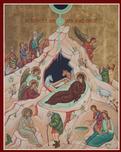
|
Icon of the Nativity of Our Lord Jesus Christ (Image)This icon is more than just a beautiful Christmas piece. It conveys important theological truth as all icons do. Jesus is wrapped in swaddling cloths in such a way that he resembles one wrapped for burial. This indicates that He was born to die for us. The red heifer is present in the cave, which is symbolic of being offered as a sacrifice for the sins of the people. The ass which bore Mary and Him out of town for his birth is there foreshadowing the Triumphal Entry as He goes willingly to the Cross to reconcile us to Himself. The angel in the mountains is shown above two shepherds. This tells the story of how the angel appeared to the shepherds singing and glorifying the birth of Christ, calling them to join in the praise. St. Joseph the Betrothed is shown in a struggle against his temptation. The old man talking to him represents his temptation, when he considered "putting Mary away quietly" not knowing whose child she was to bear. The three men on horseback are the Magi following the star that is being guided by God so they can worship the King, Jesus Christ. |

|
Icon of the Nativity of the Theotokos (Image)"Nothing about this event is mentioned anywhere in the Holy Scriptures. But why should there be? Is there anything remarkable, anything especially unique about the normal birth of a child, a birth like any other? And if the Church began to commemorate the event with a special feast, it was not because the birth was somehow unique, miraculous, or out of the ordinary; but because, on the contrary, the very fact that it is routine discloses something fresh and radiant about everything we call 'routine and ordinary, it gives new depth to the "unremarkable" details of human life.
What do we see in the icon of the feast when we look at it with our spiritual eyes? There on the bed lies a woman, Anna according to Church tradition, who has just given birth to a daughter. Next to her is the child's father, Joachim, according to the same tradition. A few women stand by the bed washing the newborn baby for the first time. The most routine, unremarkable event. Or is it? Could it be that the Church is telling us through this icon that every birth, every entrance of a new human being into the world and life is a miracle of miracles, a miracle that explodes all routine, for it marks the start of something unending, the start of a unique unrepeatable human life. The beginning of a new person. And with each birth, the world is itself in some sense created anew and given as a gift to the new human being to be his life, his path, his creation." (Father Alexander Schmemann.) |
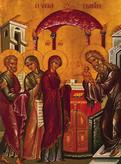
|
Icon of The Presentation (Meeting) of Our Lord (Image)Forty days after Jesus Christ's birth, the Theotokos and her betrothed, Joseph, brought her Son to the Temple to make the customary offering for purification; a pair of turtledoves or two young pigeons. There, the prophetess Anna and the aged Simeon met them. St. Simeon, one of the translators of the Septuagint, sensed the fulfillment of Isaiah's puzzling prophecies of a virginal birth (Isaiah 7:14), and received the young pre-eternal God Incarnate just as he was promised he would before his death. Then St. Simeon praised God and said, "Now lettest Thou Thy servant depart in peace, O Master." |
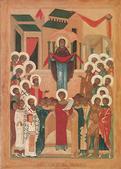
|
Icon of the Protection of the Theotokos (Image)On October 1, 911, at 4 AM, the Mother of God appeared above the people in the crowded Blachernae Church of the Mother of God in Constantinople, during an all night vigil. She had in her outstretched hands a long veil. St. Andrew the Fool for Christ was standing in the back. He said to his disciple Epiphanius, "Do you see how the Queen and Lady of all is praying for the whole world?" Epiphanius replied, "Yes, Father; I see it and stand in dread." They are depicted in the lower right of these icons. This reminds us of how the Theotokos intercedes for those who ask in time of distress. |

